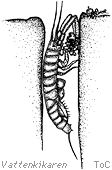|

|
|
More about the mud shrimp
Skillfull diggers
Many shallow soft bottoms are perforated
by holes that are a few millimetres in diameter. It is usually the mud
shrimp that has made these holes. The mud shrimp uses tixotropi
when it digs. When it stands on the bottom and waves the legs on the middle
of its body, a furrow is made into which the body of the mud shrimp sinks.
It is then that it is able to dig its large antennae into the sediment.
Around the mouth, the transformed and brush furnished legs make the hole
even larger. When the mud shrimp reaches sluggish sediment it kicks with
the rear of its body and legs and pushes itself foreward and downward.
When it has got the whole of its body into the sediment, it starts waving
its middle legs again and in this way digs even further down into the
sediment. A fountain of particles is squirted out while it is digging
the new whole. While the mud shrimp continues digging its semi-circled
hole, occasional eruptions of sand and other debris squirt out of the
hole. After awhile the mud shrimp will show itself about 1-2 cm from where
it disappeared into the sand. It can take 2-3 minutes for the mud shrimp
to dig its hole. Often the holes are only a few centimetres deep, but
holes as deep as 10 cm have been found. In the same way, as with other
burrowing creatures, the mud shrimp affects the oygen
content in the sediment and there by, the distribution of smaller
organisms on the bottom.
Decorates with detritus
|
When the mud shrimp has dug its U-shaped tunnel it stops squirting
out debris. Instead it starts collecting material from the orifice
with the use of its antennae. The antennae feel the surroundings
carefully and collect organic material that it packs together and
pulls into its hole. Here, the mud shrimp works the organic debris
with the use of its mouth.
|

|
|
|
Page
1 of 3
|

|
|